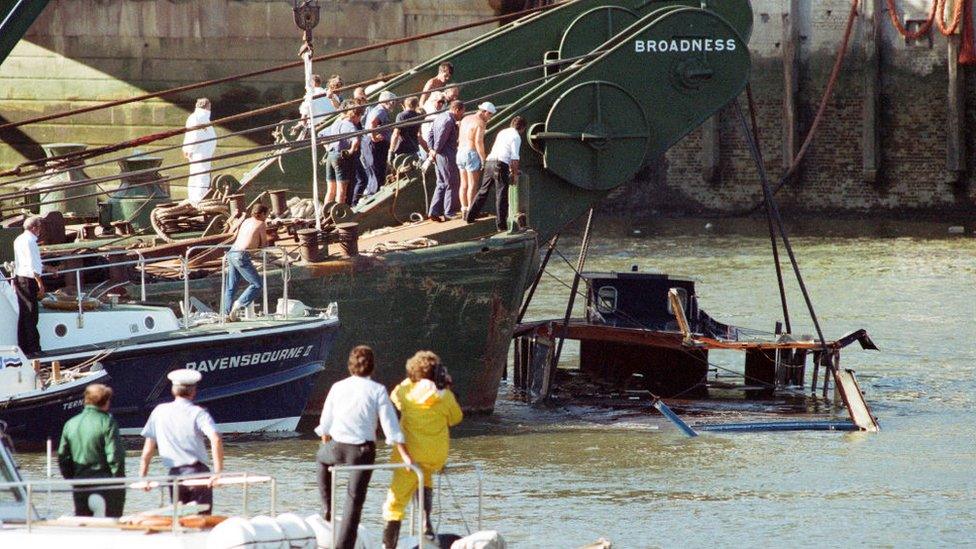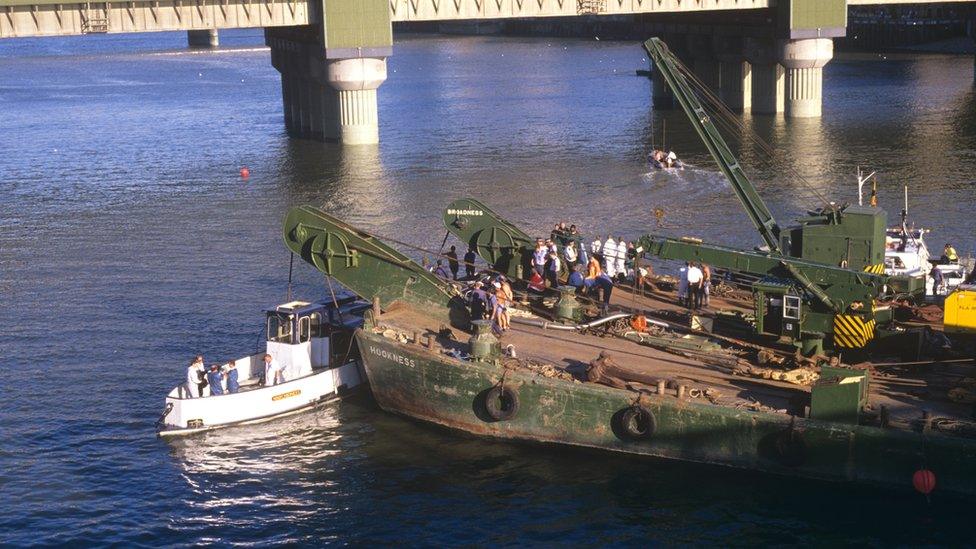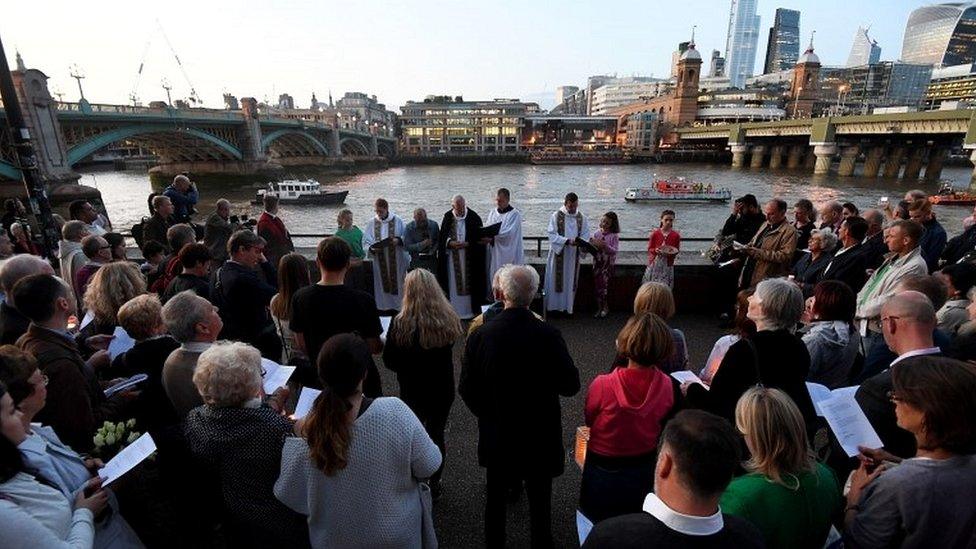Marchioness disaster: Thames historic vessels 'still not modernised'
- Published
The night of the Marchioness disaster
The "most basic" safety recommendation made after the Marchioness disaster has yet to be implemented, the Port of London Authority (PLA) has said.
On 20 August 1989, 51 people died when the Thames riverboat sank after being struck by a dredger near Southwark in the early hours of the morning.
An inquiry into the disaster ordered historic vessels on tidal rivers be brought up to modern safety standards.
"It is high time this was acted on," the PLA said.
A vigil was held beside the river on Monday evening to pay tribute to those who were killed in the tragedy.

The boat sank after being struck by a dredger
The Maritime and Coastguard Agency has put forward safety proposals, external on boat buoyancy in historic vessels after a collision.
Modern vessels' hulls are required to be divided into watertight compartments, so any flooding resulting from a breach can be more easily contained.
It has been claimed introducing these measures for historic boats that sail on the Thames - some of which were used in the Dunkirk evacuation of World War Two - could reduce seating and cost smaller commercial vessels revenue, forcing them off the river.

The Marchioness Disaster and its aftermath

On 20 August 1989, 131 people were on board the Marchioness when it was hit by the dredger Bowbelle
51 people died
Coroner Dr Paul Knapman decided to cut the hands off more than 20 victims for identification purposes
A public inquiry held in 2000 said poor lookouts on both vessels were responsible for the collision
The captain of the Bowbelle, Douglas Henderson, had drunk six pints of lager on the afternoon of the collision
The Metropolitan Police were "ill-prepared" and had no contingency plan for such an event, the inquiry found
January 2002, the Royal National Lifeboat Institution introduced four lifeboat stations on the River Thames.

The inquiry into the Marchioness disaster, held in 2000 with a report published in February 2001 by Lord Justice Clarke, made 30 river safety recommendations.
They were all accepted by John Prescott, the then deputy prime minister.
Requirements to introduce an air-traffic control style system to track vessels and flashing lights on bridges have since been introduced.
The section where the Marchioness disaster happened is still the most "incident-prone" today
Kings Reachruns between London Bridge and Waterloo Bridge
31%of passenger vessel incidents since 2010 on this stretch
124incidents reported since 2010 along Kings Reach
395in total along the tidal Thames over the same period
But some of the boats still operating on the Thames that have been in use on the river since the disaster of 1989 - and in some cases long before that - have not undergone the sort of changes experts would like to have seen.
"It is quite extraordinary that 30 years after Marchioness the most basic recommendation from that tragedy has never been implemented," Robin Mortimer, the PLA's chief executive said.
"These new standards may not have prevented the Marchioness disaster but you've got to decide if the safety recommendations are important enough.
"There's a good evidence base that older vessels are more involved in serious incidents, so they should be up to modern standards."
You may also be interested in:
But forcing historic boats "which have never had an accident" off the river would lead to closures of London's boatyards, Conservative London Assembly Member Tony Arbour warned.
London's two boatyards "spend their time repairing these historic boats", Mr Arbour told the London Assembly recently, external.
"If they are unable to afford to carry out the works which are required by these proposals, we will lose those boatyards," he said.
Tower Lifeboat Station is the busiest in the UK, with a lifeboat launched every nine hours on to the Thames according to the RNLI.
The campaign group Save London's Passenger Boats, which is representing many of the operators of historic vessels running tours on the Thames, declined to comment.
Marchioness families fight for justice
On Monday, survivors and families of the victims joined a procession from Southwark Cathedral to Bankside where a short service was held.
Odette Penwarden, 72, who was onboard the Marchioness, said it felt "like going inside a washing machine" as "the boat started to tip over" and "water came rushing in".
"I could feel myself losing consciousness, but I had an image of my mother and I decided I needed to get myself out," she said.

A vigil to remember those who were killed was held beside the Thames on Monday evening
Andrew Dennis, who lost his brother and four friends in the disaster, expressed his "disbelief" that boats and bridges on the river do not have more safety lights.
"You should be able to see all the arches of the bridges, all the outlines of the boats. That still riles me all these years later," the 54-year-old said.
- Published20 August 2014

- Published20 August 2014
